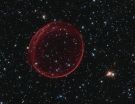(Press-News.org) Cognitive tests and MRI scans have shown significant differences in the brains of fighter pilots when compared to a control group, according to a new study led by scientists from UCL.
The study, published today in the Journal of Neuroscience, compares the cognitive performance of 11 front-line RAF (Royal Air Force) Tornado fighter pilots to a control group of a similar IQ with no previous experience of piloting aircraft. All the participants completed two 'cognitive control' tasks which were used to investigate rapid decision making. Diffusion tensor imaging (DTI), a type of MRI brain scan, was then used to examine the structure of white matter connections between brain regions associated with cognitive control.
The researchers found that fighter pilots have superior cognitive control, showing significantly greater accuracy on one of the cognitive tasks, despite being more sensitive to irrelevant, distracting information. The MRI scans revealed differences between pilots and controls in the microstructure of white matter in the right hemisphere of the brain.
Senior author Professor Masud Husain, UCL Institute of Neurology and UCL Institute of Cognitive Neuroscience, said: "We were interested in the pilots because they're often operating at the limits of human cognitive capability – they are an expert group making precision choices at high speed.
"Our findings show that optimal cognitive control may surprisingly be mediated by enhanced responses to both relevant and irrelevant stimuli, and that such control is accompanied by structural alterations in the brain. This has implications beyond simple distinctions between fighter pilots and the rest of us because it suggests expertise in certain aspects of cognition are associated with changes in the connections between brain areas. So, it's not just that the relevant areas of the brain are larger – but that the connections between key areas are different. Whether people are born with these differences or develop them is currently not known."
The study tasks were designed to assess the influence of distracting information and the ability to update a response plan in the presence of conflicting visual information. In the first task, participants had to press a right or left arrow key in response to the direction of an arrow on a screen in front of them, which was flanked by other distracting arrows pointing in different directions. In the second task, they had to respond as quickly as possible to a 'go' signal, unless they were instructed to change their plan before they had even made a response.
The results of the first task showed that the expert pilots were more accurate than age-matched volunteers, with no significant difference in reaction time – so, the pilots were able to perform the task at the same speed but with significantly higher accuracy. In the second task, there was no significant difference between the pilots and volunteers, which the authors say suggests that expertise in cognitive control may be highly specialised, highly particular to specific tasks and not simply associated with overall enhanced performance.
These findings suggest that in humans some types of expert cognitive control may be mediated by enhanced response gain to both relevant and irrelevant stimuli, and is accompanied by structural alterations in the white matter of the brain.
INFORMATION:
The research was supported by funding from the Wellcome Trust, the Medical Research Council and the NIHR Specialist Biomedical Centre at UCL/UCLH.
Notes to Editors
For more information or to interview the researchers quoted, please contact Ruth Howells in the UCL Media Relations Office on tel: +44 (0)20 7679 9739, mobile: +07790 675 947, email: ruth.howells@ucl.ac.uk
The paper, 'Expert cognitive control and individual differences associated with frontal and parietal white matter microstructure' by Roberts RE, Anderson E & Husain M is published in the Journal of Neuroscience on Wednesday 15th December 2010 embargoed to Tuesday 14th December 2010, 22.00 UK time (17.00 Eastern time)
Journalists requiring advance copies of the paper should contact UCL Media Relations.
Images are available from: www.defenceimages.mod.uk Please check copyright and credit correctly.
Dr R. Edward Roberts is now at the University of Cambridge, but was at UCL when this study was conducted.
About UCL (University College London)
Founded in 1826, UCL was the first English university established after Oxford and Cambridge, the first to admit students regardless of race, class, religion or gender, and the first to provide systematic teaching of law, architecture and medicine. UCL is among the world's top universities, as reflected by performance in a range of international rankings and tables. Alumni include Marie Stopes, Jonathan Dimbleby, Lord Woolf, Alexander Graham Bell, and members of the band Coldplay. UCL currently has over 13,000 undergraduate and 9,000 postgraduate students. Its annual income is over £700 million. www.ucl.ac.uk
About the Wellcome Trust
The Wellcome Trust is a global charitable foundation dedicated to achieving extraordinary improvements in human and animal health. It supports the brightest minds in biomedical research and the medical humanities. The Trust's breadth of support includes public engagement, education and the application of research to improve health. It is independent of both political and commercial interests. www.wellcome.ac.uk
About the MRC
For almost 100 years the Medical Research Council has improved the health of people in the UK and around the world by supporting the highest quality science. The MRC invests in world-class scientists. It has produced 29 Nobel Prize winners and sustains a flourishing environment for internationally recognised research. The MRC focuses on making an impact and provides the financial muscle and scientific expertise behind medical breakthroughs, including one of the first antibiotics penicillin, the structure of DNA and the lethal link between smoking and cancer. Today MRC funded scientists tackle research into the major health challenges of the 21st century. www.mrc.ac.uk
Fighter pilots' brains are 'more sensitive'
2010-12-15
ELSE PRESS RELEASES FROM THIS DATE:
Environmental pharmaceutical contamination removed by Octolig
2010-12-15
An article in the current issue of TECHNOLOGY & INNOVATION, Proceedings of the National Academy of Inventors ™ http://www.cognizantcommunication.com/filecabinet/Technology/techinnovation.html reports on the removal of certain dyes and the antibiotic amoxicillin from water samples using Octolig ®, a commercially available material.
"Because of their properties and the magnitude of their production and use, pharmaceuticals can represent a serious disposal problem," said corresponding author* Dean F. Martin, PhD, of the University of South Florida's Institute for Environmental ...
2 people receive kidney transplants in pilot program using CMU software
2010-12-15
PITTSBURGH—A man in St. Louis and a woman in New Hampshire have received the first kidney transplants made possible through a new national program of the Organ Procurement and Transplantation Network (OPTN) that uses a Carnegie Mellon University computer algorithm to match transplant candidates with living donors.
Both recipients — Ken Crowder of St. Louis and Kathy Niedzwiecki of Pelham, N.H. — had loved ones who were willing to donate a kidney but who were medically incompatible with them. So, through a paired donation, Mr. Crowder's fiancée, Rebecca Burkes, donated ...
A protein called cFLIP makes tumor cells in breast cancer resistant to treatments
2010-12-15
Researchers at the Andalusian Institute for Molecular Biology and Regenerative Medicine (CABIMER) and the University of Granada found that cFLIP –an inhibitor of death ligand-induced apoptosis– is not only essential in breast tumor cells resistance to TRAIL treatments (a death ligand with a potent therapeutic potential against cancer), but this protein is also key to the survival of such cancer cells.
Researchers proved that a variation in the expression of this protein may lead to the normal development of breast epithelium. This is an important finding to be considered ...
Hubble spots a celestial bauble
2010-12-15
The delicate shell, photographed by the NASA/ESA Hubble Space Telescope, appears to float serenely in the depths of space, but this apparent calm hides an inner turmoil. The gaseous envelope formed as the expanding blast wave and ejected material from a supernova tore through the nearby interstellar medium. Called SNR B0509-67.5 (or SNR 0509 for short), the bubble is the visible remnant of a powerful stellar explosion in the Large Magellanic Cloud (LMC), a small galaxy about 160 000 light-years from Earth.
Ripples seen in the shell's surface may be caused either by subtle ...
What 'pine' cones reveal about the evolution of flowers
2010-12-15
From southern Africa's pineapple lily to Western Australia's swamp bottlebrush, flowering plants are everywhere. Also called angiosperms, they make up 90 percent of all land-based, plant life.
New research published this week in the Proceedings of the National Academy of Sciences provides new insights into their genetic origin, an evolutionary innovation that quickly gave rise to many diverse flowering plants more than 130 million years ago. Moreover, a flower with genetic programming similar to a water lily may have started it all.
"Water lilies and avocado flowers ...
Unique case study on Alzheimer's disease
2010-12-15
A case study from the Swedish medical university Karolinska Institutet sheds light on the pathological course of Alzheimer's disease. The brain of the first Alzheimer's patient to display amyloids demonstrable with a PET scanner has been studied, both during progression of the disease and after death.
One pathological characteristic of Alzheimer's disease is the accumulation in the brain of beta-amyloid proteins to form amyloid plaques. However, it is not known how early the plaques forms in the brain, whether they are the primary cause of the disease or what pathogenic ...
Violent games not to blame for youth aggression
2010-12-15
How depressed young people are strongly predicts how aggressive and violent they may be or may become. Contrary to popular belief, however, exposure to violence in video games or on television is not related to serious acts of youth aggression or violence among Hispanics in the US, according to new research by Dr. Christopher Ferguson from Texas A&M International University. His findings are published online in Springer's Journal of Youth and Adolescence.
The potential negative effects of violent video games on adolescent antisocial behavior, and youth violence in particular, ...
Drug use and discrimination among Phoenix area Mexican heritage youth
2010-12-15
Washington, DC, December 14, 2010—Perceived ethnic discrimination among Mexican and Mexican American students from Phoenix-area middle schools places them at risk for increased stress when trying to acculturate with mainstream U.S. culture, according to a new study. As the students experienced acculturation stress related to discrimination, they were at a higher risk for alcohol, cigarettes, and marijuana use. The study is in the December issue of Prevention Science, a peer-reviewed journal of the Society for Prevention Research.
"As levels of perceived discrimination ...
Research leads to fewer yellowjackets on Christmas trees
2010-12-15
Hawaiians can now worry less about finding stray yellowjackets living in their Christmas trees shipped from the mainland United States, partly due to research by a U.S. Department of Agriculture (USDA) scientist and his university and state cooperators.
Every year, fir trees from the Pacific Northwest are shipped to Hawaii for use as Christmas trees. Although yellowjackets usually nest in the ground, mated queens who haven't yet built their nests sometimes make fir trees their home during winter. So, when the trees are harvested in November for shipment to Hawaii, the ...
UNH-led experiment hurtled into aurora above Norway by NASA rocket
2010-12-15
DURHAM, N.H. –- A team of scientists led by Marc Lessard of the University of New Hampshire Space Science Center launched an instrument-laden, four-stage sounding rocket from Norway's Andøya Rocket Range into aurora about 200 miles above Earth early Sunday morning (Dec. 12, 2010), just before the two-week launch window slammed shut. For the 10-minute flight, a 65-foot-long Black Brant XII rocket arced through a funnel-shaped region of Earth's magnetic field lines before landing some 900 miles downrange in the Norwegian Sea. The science data were transmitted to a ground ...

